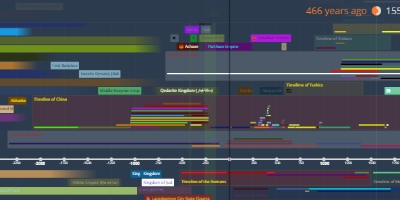State of Chu (楚) (jan 1, 1030 BC – jan 1, 223 BC)
Description:
Chu (Chinese: 楚, Hanyu Pinyin: Chǔ, Old Chinese: *s-r̥aʔ) was a Zhou dynasty vassal state. Their first ruler was King Wu of Chu in the early 8th century BCE. Chu was located in the south of the Zhou heartland and lasted during the Spring and Autumn period. At the end of the Warring States period it was destroyed by the Qin in 223 BCE during the Qin's wars of unification.Also known as Jing (荆) and Jingchu (荆楚), Chu included most of the present-day provinces of Hubei and Hunan, along with parts of Chongqing, Guizhou, Henan, Anhui, Jiangxi, Jiangsu, Zhejiang, and Shanghai. For more than 400 years, the Chu capital Danyang was located at the junction of the Dan and Xi Rivers[3][4] near present-day Xichuan County, Henan, but later moved to Ying. The house of Chu originally bore the clan name Nai (嬭 OC: /*rneːlʔ/) which was later written as Mi (芈 OC: /*meʔ/). They also bore the lineage name Yan (酓 OC: /*qlamʔ/, /*qʰɯːm/) which would later be written Xiong (熊 OC: /*ɢʷlɯm/).
According to legends recounted in Sima Qian's Records of the Grand Historian, the ruling family of Chu descended from the Yellow Emperor and his grandson and successor Zhuanxu. Zhuanxu's great-grandson Wuhui (吳回) was put in charge of fire by Emperor Ku and given the title Zhurong. Wuhui's son Luzhong (陸終) had six sons, all born by Caesarian section. The youngest, Jilian, adopted the ancestral surname Mi. Jilian's descendant Yuxiong was the teacher of King Wen of Zhou (r. 1099–1050 BCE). After the Zhou overthrew the Shang dynasty, King Cheng (r. 1042–1021 BCE) enfeoffed Yuxiong's great-grandson Xiong Yi with the fiefdom of Chu and the hereditary title of 子 (zǐ, "viscount"). Then the first capital of Chu was established at Danyang (present-day Xichuan in Henan).
Freed from its difficulties with Wu, Chu annexed Chen in 479 BCE and overran Cai to the north in 447 BCE. However, eventually Chu was completely obliterated by the Qin dynasty (Lu was conquered by King Kaolie in 223 BCE). By the end of the 5th century BCE, the Chu government had become very corrupt and inefficient, with much of the state's treasury used primarily to pay for the royal entourage. Many officials had no meaningful task except taking money and Chu's army, while large, was of low quality.
During the late Warring States period, Chu was increasingly pressured by Qin to its west, especially after Qin enacted and preserved the Legalistic reforms of Shang Yang. In 241 BCE, five of the seven major warring states–Chu, Zhao, Wei, Yan and Han–formed an alliance to fight the rising power of Qin. King Kaolie of Chu was named the leader of the alliance and Lord Chunshen the military commander. According to historian Yang Kuan, the Zhao general Pang Nuan (庞煖) was the actual commander in the battle. The allies attacked Qin at the strategic Hangu Pass but were defeated. King Kaolie blamed Lord Chunshen for the loss and began to mistrust him. Afterwards, Chu moved its capital east to Shouchun, farther away from the threat of Qin.
As Qin expanded into Chu's territory, Chu was forced to expand southwards and eastwards, absorbing local cultural influences along the way. By the late 4th century BCE, however, Chu's prominent status had fallen into decay. As a result of several invasions headed by Zhao and Qin, Chu was eventually completely wiped out by Qin.
Added to timeline:
Date:
jan 1, 1030 BC
jan 1, 223 BC
~ 807 years
